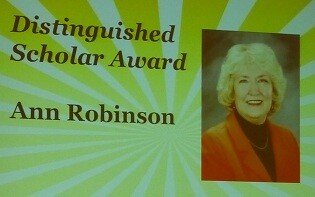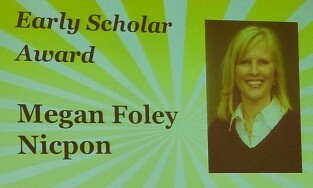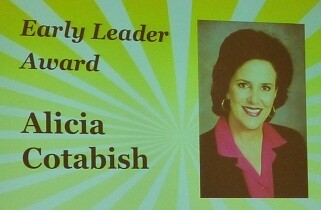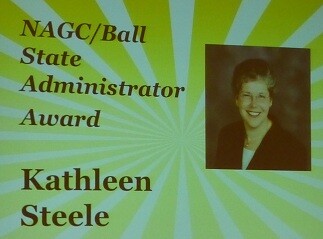NAGC Executive Director Nancy Green and NAGC President Paula Olszewski-Kubilius kicked the day off this morning with an opening general session about “Gifted Leading the Way: National Priorities and Opportunities for Action.” Nancy presented three NAGC policy goals:
* The need to hold schools and states accountable for reaching and meeting the needs of the gifted and advanced students in their classrooms. We need to combat schools’ complacency about the real needs of gifted learners. These kids won’t just “be fine on their own,” as those of us in the field know all too well.
* Remove barriers to access to talent development and gifted education services. Whether or not a student receives services to meet their unique learning needs shouldn’t depend upon their zip code.
* Ensure all school leaders and classroom teachers are able to recognize indicators of high achievement and are able to meet the learning needs of high-ability students. Pre-service preparation and career-concurrent professional development need to include information and strategies so teachers can reach these kids.
(My own little aside here: I think the first sentence of the third bullet above should also somewhere include the phrase “high potential,” too.)
Paula referenced the recent report released by NAGC about “Unlocking Emergent Talent: Supporting High Achievement of Low-Income, High-Ability Students.”
Among the findings reported were the following:
* The U.S. produces fewer students scoring at the highest levels of achievement in reading, math, and science on the PISA compared to countries such as New Zealand, Canada, China, Singapore, Finland, and Japan.
* Less than 8% of U.S. students score at excellent levels in reading, math, or science on the NAEP tests.
* Of students who qualify for free or reduced lunch, only about 1% of them score at the advanced level on the 8th grade NAEP exam. For students who qualify for free lunch, the percentage is even lower.
A PDF of the full report is available for download at this link.
Ideas presented for better reaching high-ability low-income students were great. “Identifying transferable or replicable program models that are economically feasible.” “Providing training to teachers in low-income and rural schools.” “Resolving conflicts between achievement and affiliation.” “Provide enrichment to all students starting in preschool.” “Make the cultivation of high-potential learners starting as early as Kindergarten a priority.” “Include excellence gaps in discussions of achievement gaps.”
My morning Gifted Education Applications session was “Gifted Education: A Sherpa for Guiding Everyone to New Heights” with Sally Krisel of Hall County Schools in Gainesville, Georgia. After meeting her at the Hormel Symposium in Minnesota this summer, I’ve been hoping to learn more about her work as coordinator of “Charter Schools and Programs of Choice” for Hall County Schools.
She began by making some inspiring and thought-provoking powerful statements. “We will never have the schools we want for children by focusing on adequacy.” “Parents and students are ready for something new and innovative.” “For too long we’ve offered kids and their parents two choices: Take it or leave it.” “Schools should compete for ‘intelletes’ like we do for athletes.”
Sally talked about the power of gifted education to promote excellence for an entire school district. She pointed out that India and China have more honor students than we have total students. We as a nation cannot afford to only seek the highest levels of excellence for a narrow band at the top. We as a nation have a fundamental decision to make: Do we continue to hammer away at a focus on adequacy and remediation, or are we going to focus on a culture of excellence, high expectations, potential, and creativity.
Basically, good enough is not good enough! It never was, but we have behaved as if it was for far too long.
“Rigor for all” is not just a sound-bite. Sally’s challenge was to lead the incorporation of this concept for all students in Hall County. The challenge has manifested in more than 20 of the district’s 32 schools being transformed in the last few years to charter, academy, and “niche” or magnet learning environments.
Among the results: Twenty-seven high school courses are offered to middle school students. The district has met its goal of 75% of students leaving middle school with at least 1 high school credit. The district sought a waiver from the state to allow part-time enrollment at the middle school level so that homeschooled children could partake of a portion of a school day at a charter or choice school. (Most of these part-time students have since become full-time students because they loved so much what they found.)
I hope to interview Sally and do a more in-depth post in the near future about how the Hall County Charters and Choice Programs have impacted learning for not only gifted students, but all children. It really was an eye-opening and inspiring look at what choice and challenge can do for our nation’s youth.
My afternoon session was “Early Entrance Programs for Young Gifted Children: Preparing Four Year-Olds for Kindergarten” presented by Melinda Ness and Kimberly Chandler. The presenters did a great job outlining what the research says about early entrance to Kindergarten (adults who understand and support it are key to the child’s success, for example), arguments that people use against early entrance (all the other kids will be driving sooner, for example), and arguments in favor of early entrance (kids who qualify for this option typically do have the social and emotional maturity enabling them to be ready to start Kindergarten “early” - though in reality it is “right on time” for them).
Melinda spoke of the process her district (Littleton Public Schools, CO) uses when assessing whether a child is ready for early entrance to Kindergarten. 1) When Kindergarten screening is advertised, it is also mentioned that applications for early entrance will also be taken at the same time. 2) Contacts are established between the parents and the District GT Coordinator. 3) The parents gather for and pass onto the District Coordinator any and all forms of data available on their child that might lend insight into whether the child is ready for Kindergarten. This often also includes a letter from a preschool teacher, a formal parent observation inventory, examples of the child’s abilities in language and mathematics, and any other available anecdotal and/or statistical data. This portfolio is then examined by the District Coordinator and a team consisting of primary grade teachers, GT Specialists, administrators, and appropriate others. 4) The student is interviewed at the time of the portfolio review. 5) The District Coordinator refers the student for individual testing by the school psychologist. With all of this information and data, a decision is made. I found myself intrigued by the comprehensive effort to gather all possible information on the child (rather than a single piece of data). In this district, they are making great effort to not only let parents know early entrance is an option, but also to make a highly-informed decision about each child.
The presenters gave examples of possible observation-based and statistical instruments to use in this process:
Kingore Observation Inventory for Parents
Preschool & Kindergarten Behavioral Scales (PBKS-2)
Individual School Reading Inventories
Individual School Math Placement tests
Scales for Rating the Behavioral Characteristics of Superior Students-R (SRBCSS-R)
Young Children’s Academic Intrinsic Motivation Inventory (Y-CAIMI)
Wechsler Intelligence Test (WPPSI)
Differential Abilities Scale (DAS)
Ravens Matrices (sorry... could not find a good link!)
Test of Early Mathematics Ability (TEMA)
Test of Early Reading Ability (TERA)
Throughout, the process and particularly the outcome are flexible to the needs and readiness of the child. Once a child is approved for early entrance, the school and District Coordinator continue to monitor and support the child by allowing a period of adjustment, helping the child develop self-efficacy, supporting all stakeholders (child, child’s parents, child’s teacher), and assuring access to appropriate resources. And always, keep in mind that the child might be in need of additional and subsequent forms of acceleration as well.
It’s about flexibility, flexibility, flexibility.
Additional resources:
* The “Nation Deceived” report from a few years back provides additional and illuminative research data on early entrance and other forms of acceleration.
* Acceleration for Gifted Learners, K-5 by Joan Smutny, Sally Walker, and Elizabeth Meckstroth
* The Academic Acceleration of the Gifted Children by Thomas Southern, Eric Jones, and William Southern
* Gifted Child Quarterly 2007: 51, 330 “The Socioaffective Impact of Acceleration and Ability Grouping: Recommendations for Best Practice” by Maureen Neihart
The Opening Keynote with Chester Finn of the Thomas B. Fordham Institute was preceded by some great student entertainment, including a beautiful choir and these boys from Break EFX who dazzled the audience:


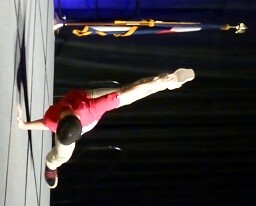
Chester Finn was selected as the recipient of this year’s 2012 NAGC President’s Award. He acknowledged up front in his address that while not an educator, while not trained in the characteristics and needs of gifted learners, he has - through his work over decades in education policy - taken up a keen interest in policy influences on “high-potential, academically-inclined” learners - and the direct and indirect impact that has on our nation’s security and success. Much of Fordham’s research (Do High Flyers Maintain Their Altitude?, High-Achieving Students in the Era of NCLB, etc.), sad to say, shows big problems for our nation’s gifted and advanced learners. In terms of equity, this is “a human capital catastrophe for the U.S.”
Finn focused his presentation into an organized list answering the question, “Why are we messing this up?”
1) Nervousness about elitism, fed by underrepresentation of certain populations.
2) A mindset, particularly in this time of budget cuts and a focus on low-achieving students, that those with high ability will do fine on their own.
3) A widespread belief that broader equity concerns are confined to issues of income, race, disability - and getting everybody up to some modest floor level is the goal. (His implication was that the broader world of education and our society don’t see the gifted as a “minority” population with valid needs.)
4) We in education send mixed messages as to whether giftedness constitutes a special need.
5) In the real world, everybody knows highly selective colleges get more applicants than they can accept, more kids are enrolled in AP and IB, so what could be the problem?
6) Our immigration policies have made it possible to import the skills we don’t find within (hence a weakened need to develop our own talent).
7) The field of gifted ed has been hazy regarding who and what they’re focused on. Lack of a clear definition and specific numbers leave outsiders confounded about the field, its mission, its beneficiaries (the kids). Little agreement doesn’t help our arguments in policy circles.
8) This field suffers from a paucity of research about what works and how that provides gains under certain circumstances to certain populations. The burden of proof about the value of what we advocate for is needed. (I think it’s out there... maybe we’re just poor at getting the message out?)
9) “Maybe because of the elitism issue, and perhaps due to a shortage of resources,” the gifted ed world has been a little meek in lobbying and advocacy, political engagement, etc., let alone recruiting candidates who are sympathetic in low, medium and high places. He said one would be hard pressed to name a current member of Congress who is a vigorous advocate gifted learners. (Actually, there is at least one easy example, Sen. Grassley of Iowa.)
10) Bad Ideas - such as the idea that everything should be open to everyone regardless of prior attainment, multiple intelligences, too much focus on differentiation. He posited that this is bad for gifted ed (i.e. the kids) because it waters down our message.
He then offered a few reasons for modest optimism:
1) Gifted ed could turn the equity argument to its advantage. In his book Exam Schools, one finding was that those schools were not populated predominately by mainstream, middle and upper income white kids. These exam schools, rather are refuges for families of little means whose children have high potential.
2) Widening awareness in the country about just how poorly our advanced students are doing compared to those in other lands. This worry and awareness is beginning to creep into opinion columns and the business media.
3) Emergence of new forms of educational delivery that will widen the options available for high ability students, such as technology, online courses (many of which are free), emergence of STEM focused schools, afterschool enrichment options, alternative schools, etc. Students and their parents are no longer confined to the status quo as an option. Gifted learners have more selection of ways to have their needs met.
4) Some schools are getting more sophisticated about meeting needs of these learners.
5) An examination of these kids and their needs in widely read media, such as the recent New York Times Magazine article about parenting prodigies and the Scientific American issue, Think Like a Genius. “Is this a sign of widening acceptance?” he wondered.
Finn continued, saying that high potential is valuable, but it’s not the whole story. Good habits, motivation, creativity, and hard work count tremendously as well. He gave an example of - and praised - an exam school highlighted in his book that selected its student based on factors beyond a test score. (I found this bit of praise a little ironic given his comments in #7 above.)
“Why keep the supply of these schools limited given the high demand?” “How much human potential is our society failing to realize?” “How much are we squandering?”
He gave everyone a lot to think about :o)
Finally, at the Awards Ceremony, NAGC President Paula Olszewski-Kubilius called for the development of a task force to generate a national education policy platform regarding gifted and advanced learners - so as to be better able to partner with others who have similar goals and interests.
Here is a selection of some of the award winners:


